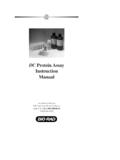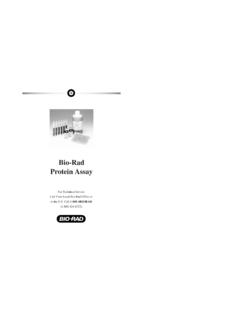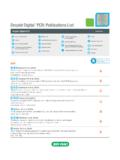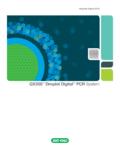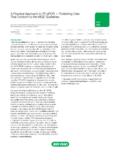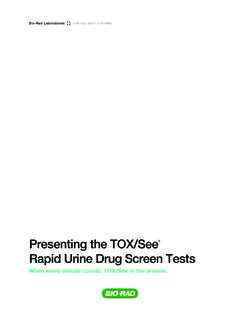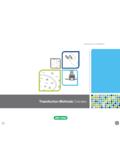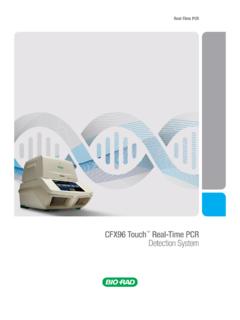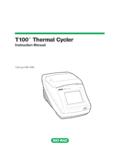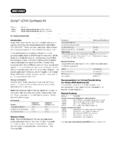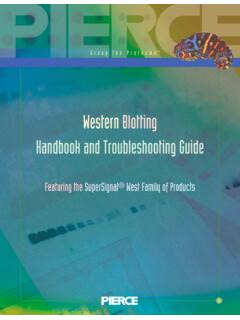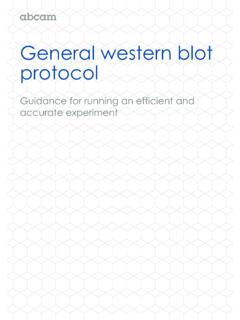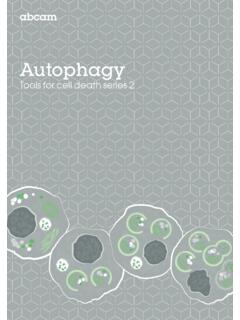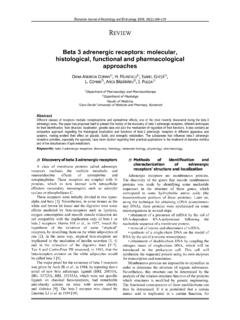Transcription of Immun-Blot PVDF Membrane for Protein Blotting …
1 Bio-Rad laboratories , 2000 Alfred Nobel Dr., Hercules, CA 945474006127 Rev AImmun-Blot PVDF Membrane forProtein BlottingInstruction 6/23/98 8:48 AM Page iiSection 2 Membrane 3 Dot Blotting ..5 Section 4 Electrophoretic Blotting ..6 Section 5 Optimization of 6 References ..10 Section 7 Product Information ..11 Table of 6/23/98 8:48 AM Page iSection 1 IntroductionPVDF (polyvinylidene difluoride) mem-brane was originally introduced to Protein use asan ideal medium for the harsh chemical environ-ment of N-terminal, or Edman degradation,sequencing. The hydrophobicity of PVDF makes it an ideal support for binding proteins inelectrophoretic and dot Blotting of the hydrophobic nature of PVDF, itdoes require a prewetting step in alcohol.
2 Thehigh Protein binding capacity, target retention,and resistance to cracking has made PVDF anappealing Membrane for general lab techniques. The two main applications for PVDF are N-Terminal Sequencing and Immunoblotting, bothof which benefit from the qualities of PVDF butin different aspects of the Membrane . Whilesequencing work is concerned with retaining 6/23/98 8:48 AM Page 1can be added to the transfer buffer withoutaffecting the binding of the Protein to results are consistently clean, easy to readblots. The physical strength of Immun-BlotPVDF Membrane means that it will not crack ortear in common handling, and holds up underrepeated strip and reprobing 2 Membrane WettingImmun-Blot PVDF Membrane can be usedas a direct replacement for the Membrane cur-rently being used in your Blotting protocol.
3 Nochanges are required in the procedure, but thespecial steps given below are required to pre-pare the Membrane for Blotting . The hydropho-bicity of PVDF makes it impossible to wet themembrane with aqueous solutions. Methanol oran alternative organic solvent is required to pre-wet the Membrane prior to equilibration in3much Protein as possible, a western blot requiresgood signal retention with very low order to provide the best possible membranefor each technique, Bio-Rad offers two gradesof PVDF, Immun-Blot PVDF for western blot-ting, and Sequi-Blot PVDF for Protein PVDFThe purpose of a Blotting Membrane is todeliver good signal results while resisting back-ground and non-specific binding. Immun-BlotPVDF Membrane is ideal for chemiluminescentand colorimetric western blots because it retainstarget Protein very strongly, 140 150 g pro-tein/cm2membrane, but resists background thatcan obscure high sensitivity detection.
4 Immun-Blot PVDF Membrane retains proteins in anytransfer format; tank Blotting , semi-dry Blotting ,and dot Blotting all deliver excellent results. Forproteins that are difficult to transfer, 6/23/98 8:48 AM Page 2tion. At this point, the Membrane is readyto bind proteins in any Blotting After the Membrane has been wetted withbuffer, do not allow it to dry (white spotswill form where the Membrane is dry). Protein will not bind to the dried mem-brane, and dry spots will not rewet in aque-ous solutions. If the Membrane becomesdry prior to Blotting , repeat steps 1 and 2 torewet 3 Dot BlottingDot Blotting requires special precautions toinsure that Protein is bound to the PVDF mem-brane before it dries. Directly spot Protein to thewetted Membrane and allow it to dry.
5 Vacuumassisted dot or slot Blotting is not recommend-ed, due to the potential for the PVDF to dry outbefore the proteins are buffer. After equilibration, the mem-brane can be used in a semi-dry, tank, or capil-lary Blotting system with any acidic or basicblotting buffer. Note:Always handle membranes using gloves orforceps to prevent Immerse the Membrane in 100% methanolfor a few seconds, until the entire mem-brane is translucent. In methanol, it wetsimmediately. (Solutions containing 50%methanol concentration can be used to pre-wet the Membrane .) 2. Transfer the wetted Membrane to a vesselcontaining transfer buffer or in buffer until it is equilibrated ( 2 3 minutes). The Membrane will floaton the surface of the buffer until complete-ly equilibrated.
6 After it is equilibrated it canbe easily submerged into the aqueous 6/23/98 8:48 AM Page 4 SDS imparts a net negative charge to theproteins and helps facilitate movement outof the gel. Binding of proteins to Immun-Blot PVDF Membrane is not affected by theaddition of this amount of PVDF should be clean and free of Wet the Membrane following the protocolin the Membrane wetting Make sure there are no bubbles between themembrane and the gel. 6. After transfer, rinse the Membrane threetimes (5 minutes each) with distilled water. SolutionsTowbin buffer:25 mM g192 M g20% methanol200 mlAdjust volume to 1 liter with dd the buffer before 4 Electrophoretic BlottingImmun-Blot PVDF Membrane can be usedwith a variety of transfer equipment, includingBio-Rad s Trans-Blot cell, Mini Trans-Blotcell, and Trans-Blot SD Semi Dry cell.
7 In gen-eral, tank Blotting is more quantitative withhigher binding yields than semi dry , very good results can be obtainedwhen a semi dry apparatus is used with a welloptimized gel and transfer system. The semidry transfer is much faster, with transfer timesas low as 15 minutes versus tank blottingwhich requires 1 to 3 hours for For most proteins, use a Towbin buffer1with methanol (MeOH). 2. For proteins that resist transfer out of thegel, up to SDS can be added to thetransfer buffer. This stabilizes the effect ofmethanol in stripping SDS off the 6/23/98 8:48 AM Page 6tocol. Bio-Rad s Immun-Blot colorimetric blot-ting kits, or Immun-Star chemiluminescentkits have excellent Blotting minimize non-specific background, theblocking step and antibody titers are veryimportant optimization steps.
8 For blocking, werecommend casein or non-fat dry milk. Typicalconcentrations are from to 5%. Antibodydilution factors vary by the manufacture of theantibody, the specificity, and the purity. Tooptimize blot conditions, cut the PVDF intostrips, wet the Membrane , and spot the test pro-tein directly to the Membrane . Use differentblocking concentrations and antibody titers totest the outcomes of these different the blocking and antibody conditions areset, you should have good signal to noise resultson the real electrophoretic buffer:Towbin buffer as above with addition of upto SDSNote: Do not add acid or base to adjust will range from pH to , depending on thequality of Tris, glycine, dd H2O, and should be analytical reagent grade, as metalliccontaminants in low grade methanol will plate on 5 Optimization of BlottingConditionsImmun-Blot PVDF Membrane is a veryversatile Blotting Membrane .
9 It can be used withany of the Blotting procedures that are used forimmunospecific antigen detection, or total pro-tein staining. Use the protocol developed foryour lab. If you do not have a standard protocol,most Blotting reagent kits will have a good 6/23/98 8:48 AM Page 8 Section 7 Product InformationCatalogNumberProduct DescriptionImmun-Blot PVDF Membrane162-01747 x cm,10 sheets162-017510 x 15 cm,10 sheets162-017620 x 20 cm,10 sheets162-017726 cm x m,1 rollBlotting Equipment170-3910 Trans-Blot Electrophoretic Transfer Cell170-3946 Trans-Blot Cell with Plate Electrodes170-3930 Mini Trans-Blot Cell170-3940 Trans-Blot SD Semi-Dry Transfer Cell11 Note: The Membrane can be stored after proteins havebeen transferred, but prior to immunoblotting.
10 Store itdry and rewet it when needed. To dry the Membrane ,place it on filter paper and let it dry at room temperaturefor a few hours. When you are ready to analyze the blot-ted samples, rewet the Membrane by placing it in 100%methanol or into a staining solution that contains at least50% the , technical service is available bycalling 1-800-4 BIORAD (1-800-424-6723).Our Technical Service representatives areavailable to answer your questions from 8 AMto 5 PM (PST).Section , H., Staehelin, T. and Gordon, J., Acad. Sci. USA, 76, 4350-4354 (1979). 6/23/98 8:48 AM Page 10 CatalogNumberProduct DescriptionBlotting Reagents161-0305 Prestained SDS-PAGE Standards,low range, 500 l161-0309 Prestained SDS-PAGE Standards,high range, 500 l161-0318 Prestained SDS-PAGE Standards,broad range, 500 l161-0324 Kaleidoscope PrestainedStandards,500 l170-6527 Colloidal Gold Total Protein Stain,500 mlRelated Blotting Detection ProductsImmun-Blot colorimetric detection kitsPremixed Substrate Reagents for ColorimetricDetectionImmun-Star chemiluminescent detection kitsIn the US, call Bio-Rad at 1-800-4 BIO-RAD (1-800-424-6723), or contact your localoffice for more information on Bio-Rad blot-ting equipment and 6/23/98 8:48 AM Page 12
